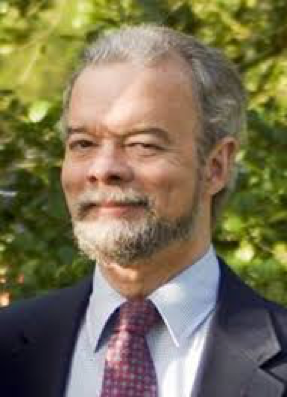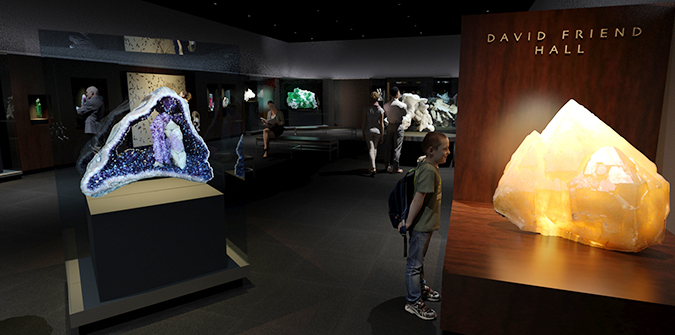May/June 2017
From Skip Hobbs: “David Friend, a pioneer in digital data cloud storage, has been a collector of fine mineral specimens all his life. He recently funded the $4 million renovation of the Yale Peabody Museum mineral collection and exhibition hall, and donated some of his unusually large and magnificent specimens. (Pictures) On October 21 the Peabody Museum held a gala opening of the David Friend Mineral Gallery, complete with dinner in the dinosaur hall. On October 22, the Peabody hosted a mineralogical symposium in the David Friend Hall that was attended by many of the nation’s top mineralogists, mineralogical museum directors, and collectors and dealers. Apollo 17 astronaut geologist Sen. Harrison ‘Jack’ Schmidt described his mineral-collecting trip to the moon!
“As a lifelong mineral collector myself, and a practicing geologist, I also attended the gala opening and symposium. It was great to reconnect with David after 46 years! The Peabody Museum is a tremendous Yale resource, and should not be missed when classmates are next in New Haven. The David Friend Mineral Gallery will take your breath away. It is spectacular!”

From the Virginia Gazette: “Neill P. Watson III, professor emeritus of psychology at the College of William and Mary and faculty member for 32 years, died on November 10 after a short illness. Respected as a teacher, colleague, and administrator, Neill focused on clinical psychology in dozens of scholarly papers and convention presentations that he wrote and coauthored. His research explored Rogerian theories of psychotherapy and ways to measure discrepancies in people’s self-concepts. He taught courses including Advanced Abnormal Psychology and Phenomenological Approaches to Psychotherapy. For the last 20 years of his tenure he was the William and Mary representative on the Council of Directors for the Virginia Consortium of Clinical Psychology. In that role he was instrumental in providing oversight and direction for the consortium’s graduate program leading to the PsyD degree. He was summa cum laude and Phi Beta Kappa at Yale. He earned his PhD in clinical psychology at Harvard. ‘A philosopher at heart,’ as one of his children described him, Neill taught his students—and his children—to view the world with a critical eye, to ask probing questions about what they observed, to persist in seeking answers, and to stay dedicated to reasoned thought. He was known to be conscientious in everything he did. Out of the classroom, Neill loved music and played guitar and sang in the jazz/R&B band Silver. An accomplished arranger, he arranged all the music the group performed, frequently devising complicated chord and key changes. He was an avid swimmer and could often be found at the gym churning up the pool. His wry sense of humor and quick wit, delivered with a twinkle in his eye, were wont to leave family and friends chortling in amazement. Quiet, deeply held spiritual beliefs led him to the Mattaponi Friends Meeting (Quakers) where he was treasurer for many years. A devoted and loving father, he leaves behind four children and two grandchildren.”
Bob Sidenberg sent us a memory: “Classmates may recall Neill sporting full leathers on his Royal Enfield motorcycle. Our Calhoun brother was a member of Fence Club and Book and Snake. ‘Skinny’ kept up his lifelong love of music, playing sweet music on his guitar.”
Laurie Mattas (lauriemattas@yahoo.com) writes of the December 31, 2016, death of her husband, Rich Mattas: “In 1965, Rich graduated from Morton West High School in Berwyn, Illinois, where he was an outstanding scholar and athlete and a member of their undefeated football team. He continued to play football at Yale, capping his career with the infamous Yale-Harvard game of 1968. After graduating from Yale in 1969 with a BA in physics, he continued his education at the University of Illinois Champaign-Urbana, where he earned an MS and PhD from the Department of Metallurgical Engineering. He and his wife, Laurie (Loretta Urbaczewski), were married in Stratford, Connecticut, on June 27, 1970. Rich’s entire professional career was spent at Argonne National Laboratory outside of Chicago, where he ultimately became manager of the Fusion Power Program and was awarded the prestigious title of senior engineer. The capstone of his career was working on the development of the International Thermonuclear Experimental Reactor currently being built in France. After building a weekend home in the Galena Territory in northwest Illinois, Rich and Laurie became involved with local groups, including the Natural Area Guardians and the Galena Territory Association where Rich served on the board and as chair of the greenspace committee.
“They retired and moved to Jo Daviess County in 2003–4 and Rich immediately became an active volunteer in many organizations. He served on the steering committee of the Jo Daviess Leadership Forum, and on the board of the Apple River Fort. He was a member of the Jo Daviess County Greenways and Trails Committee and cochair of the Riverfront Development Committee, part of the Galena Vision 2020 project. He was immediate past president of the Galena Rotary Club and was an active member of the Unitarian Universalist Church of Stockton, Illinois. But the organization he loved most and devoted much time and talent to was the Jo Daviess Conservation Foundation (JDCF). He served multiple terms as a board member, one term as president of the board and six months as interim executive director. His numerous contributions to JDCF ranged from providing photos and designing audio-visual presentations to conducting eagle-watching tours. A Renaissance man, philosopher, and bon vivant, Rich pursued a wide range of interests in his retirement. He loved photographing and painting wildlife and enjoyed writing both poetry and prose. He was a blacksmith and a bartender and a connoisseur of old movies and fine beer.”
Other deaths: Tony Yasinsac (1989) and John Thomas Graham (2012).
“The ideals which have lighted my way, and time after time have given me new courage to face life cheerfully, have been Kindness, Beauty, and Truth.”—Albert Einstein.


I only wish that these minerals were available during Rocks and Stars!
I encourage everyone to click on the OPINION section of this wonderful new website and read Fortney Stark’s (Yale ’17) essay, “A Tale of Two Cities.”
Three years ago, at our 45th reunion, I decided to take a walk up Dixwell Avenue to visit the Martin Luther King Elementary School, where I had taught 3rd and 4th grade after graduating from Yale. The King School building had been torn down and a new Amisted charter high school building was almost completed on the site. But what was most striking was that – to all appearances – the Dixwell neighborhood had not improved a drop since I had been teaching there 45 years earlier. If anything, the neighborhood seemed more raggedy, more depressed. Buildings that were new 40 years ago had deteriorated down to the level of the rest of the neighborhood. The guys hanging out on Dixwell were as numerous and their lives seemingly as painful as was the case for the guys who used to hang out on Dixwell 45 years before.
The kids I taught at the King School are perhaps grandparents now — and nothing I could see (except the one charter school building) gave any indication that Dixwell had changed at all, except perhaps that the neighborhood had become even more disenfranchised and even more economically distressed, as far as I could tell, in the 40+ years that had passed.
As I was looking around, a police officer pulled her cruiser over next to me and — based, I assume, on my age and race (white) — she explained to me, with a tone of clear frustration, “Sir, this is not a place to be sightseeing” – and drove away.
If you had told me, in 1969 when we graduated from Yale, that – – 45 years later! – – Dixwell would not, in any visible way, have improved at all as a neighborhood, I would not have believed that that could possibly be the case. I would have found it unimaginable. Yet the staggering disparities between wealth and poverty which begin a few yards from the Payne Whitney gym are still routine realities in New Haven, and in almost every city in America.
Please read Fortney “Fish” Stark’s article. As we return to Yale after decades of our own successes and struggles, as we return once again to the cannot-be-denied gaps between Yale, our island of wealth, and the destitute city which surrounds it –-are there ways that OUR visibility, connections, and resources can focus on problems at our doorstep, which remain so painfully unchanged five decades after our own “bright college years”?
My email address is barney.brawer@thenationalclassroom.com if anyone wishes to respond to my thoughts directly or on this Class of ’69 website. Thank you.
I apologize that the paragraphing in my note above wasn’t clearer! – Barney